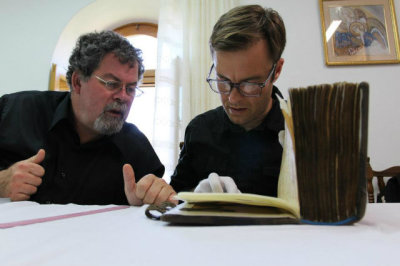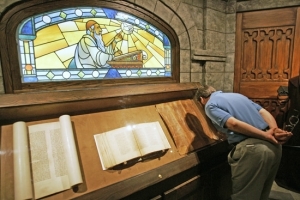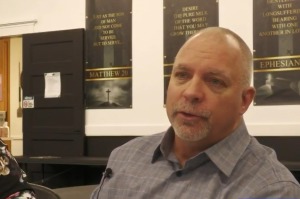New Testament Scholar: Chasing Biblical Manuscripts Is Nothing Like 'Indiana Jones'
Dallas Theological Seminary professor and New Testament scholar Daniel B. Wallace has a very busy life, and likes it that way.

"We've got one life to live and we need to use it productively for the Lord," Wallace told The Christian Post during a recent interview for a series on Bible translation.
The theologian's name is known by students who have pored over his Greek grammar textbook or read any of the several books he has contributed to, authored or edited. Wallace also belongs to a handful of scholarly groups, such as the Society of New Testament Studies and the Evangelical Theological Society. Additionally, the highly respected textual critic has served as the senior New Testament editor of the NET Bible and has contributed to or served as consultant for four other Bible translations. He is currently producing work on the Gospels of John and Mark on nascent Christology.
Wallace seems to get the most joy, however, from his work at the Center for the Study of New Testament Manuscripts, a nonprofit organization he founded in 2002 located in Plano, Texas. Wallace, CSNTM's executive director, organizes expeditions for his team to track down ancient biblical manuscripts around the world to digitize them for preservation and study.
The 60-year-old says he enjoys the work, likes being busy and has little value for what he calls "wasted time."
"I do take time off for myself," he admitted. "I don't take a lot of time off though."
Wallace's work with the CSNTM is not only "fun, exciting and thrilling," but it's also a ministry – one that allows him to travel the world, encounter new cultures and break ground in the area of biblical research.
The center's global travels may evoke images of Indiana Jones fighting Nazis in Germany for the Ark of the Covenant or the Holy Grail, a comparison Wallace is used to. After all, acquiring access to delicate and rare texts has taken his team to ancient locales like Constantinople (Istanbul, Turkey) and the Greek island of Patmos.
Although CP was told that the team at CSNTM does indeed "love the Indiana Jones myth," Wallace says his team's expositions to document valuable texts are nothing like Indiana Jones' wild adventures.
First of all, they don't steal.
"The problem with Indiana Jones, he was actually an American imperialist thief. He goes into a country and goes 'this artifact belongs in a museum. It doesn't belong with you people,'" Wallace clarified. "What we do is, our first task is always to protect the manuscript at all costs. We treat these manuscripts like they are our own children. Consequently, the libraries, they absolutely love what we're doing. So we're not stealing anything at all."
Neither do they have people shooting or chasing after them, which Wallace may or may not find disappointing.
But much of the excitement surrounding the Center for the Study of New Testament Manuscripts lies in its impressive accomplishments.
In 2007, a CSNTM team left the U.S. to visit the National Archives in Tirana, Albania, in hopes of digitizing 13 manuscripts over a three-week period. The center takes high resolution photographs of manuscripts with the help of a Graz Travelers Conservation Copy Stand, an expensive piece of equipment that allows a user to hold a book or manuscript in place so that it can be photographed, which CSNTM does with its manuscripts one page at a time.
The team sent to Albania discovered upon their arrival at the National Archives that instead of the 13 manuscripts they were expecting, there were more than 45 Greek New Testament manuscripts made available to them. The digitizing process eventually required the help of a second team and three additional weeks.
"They took, I think, 18,000 pictures in six weeks, which was a substantial sum," explained Wallace. "A lot of these manuscripts were new discoveries, about two dozen new discoveries. This was the second largest discovery of New Testament manuscripts that had been made in the last 50 years."
CSNTM's unique cache made headlines around the world, including on The Christian Post.
Since its founding, the center has discovered 75 Greek New Testament manuscripts that were previously unknown to Western scholars and, according to Wallace, has managed to discover more manuscripts than all of the individuals and institutes in the world put together have found. The center has so far digitized more than 200,000 pages of New Testament text, although there are about 2.6 million pages of Greek manuscripts known to the world.
"If we had the proper funding, which would be about $10 or $12 million, we could get the whole project done in 10 years. We have the equipment, we have the trained personnel, what we need is the funding. Then we can get the permissions," Wallace explained.
He added, however, that despite the challenges to raise funds, "We're pleased with how God is opening doors for us and we're able to photograph manuscripts all over the world."
The professor shared with CP some of his travel plans for this summer, although he wouldn't give specific city names.
"We go to Greece every year, and we'll be going there again this time to central Greece. ... We're going to a former Soviet Bloc country, and that's as much as I can tell you on that. But it's going to be an extraordinarily significant site. We were hopefully going there last summer, but things didn't quite work out. But it looks like it's going to work out for this coming summer. We'll also be going to a very important site in the Middle East to photograph manuscripts this year," said Wallace.
While Wallace is particularly excited about the direction of CSNTM, the academic world has also been buzzing with excitement about the scholar's announcement last year that he was privy to what is believed to be the earliest known fragment of the Gospel of Mark, one of four New Testament books that chronicles the life and ministry of Jesus. Wallace shared in an interview last year that there were actually six other manuscripts discovered, all dated to the second century; the Gospel of Mark fragment has reportedly been dated to the first century, making it very unique among known manuscripts.
When recently asked by CP about the historical find, the New Testament scholar was mum, revealing that a nondisclosure agreement prevents him from speaking about it presently. He promised, however, that news would be forthcoming.
A separate manuscript discovery that recently shook both the public and the academic community and gave rise to heated debates about its validity – which is still being worked out by Harvard Divinity School – is the "Jesus' Wife" papyrus.
The fourth-century Coptic manuscript was unveiled last September by Harvard's Hollis Professor of Divinity Karen L. King. The one and a half by three inch-fragment, written on both sides, includes four words that translate to "Jesus said to them, my wife."
Traditional Christianity holds that Jesus was unmarried, and the Bible portrays the Christian Church as "the Bride of Christ." Nonetheless, many have debated the possibility that Christ had a literal wife.
"We're not sure exactly what this papyrus is saying," Wallace insisted when asked to comment on the fourth-century papyrus credited to Egyptian Christians. "Let's just assume for the sake of argument, and I think this is probably the case, that that fourth-century Coptic papyrus is talking about Jesus speaking about a literal wife. So what does that do to our faith? Absolutely nothing.
"We know that there were strange and bizarre groups that deviated from orthodoxy even in the first century, and so for them to do so in the fourth century is exactly what we'd expect. We'd be surprised if we didn't have that kind of thing."
He added, "People get all excited about this when there are early New Testament papyri that are being discovered, and the media doesn't even cover them at all."
It is likely, however, that the media will be paying attention when the purported first-century Gospel of Mark fragment is unveiled to the world this year, presumably through an academic journal.
In the meantime, Wallace can be expected to remain busy teaching, researching and writing, and overseeing projects at the CNTSM.
When asked how he manages to tackle so many duties, Wallace explained that remaining active on multiple fronts is a matter of time management and putting first things first.
"I believe that we tend to feel entitled to far more free time than we really should have," said Wallace, who described his lifestyle as "an adrenaline rush lifestyle."
"When you think about how many hours we have in a week (168 hours) and you think a full-time job is less than one fourth of that. I'm not so sure that really is a full-time job," he added. "I think there's a whole lot more we could be doing for the Lord. Again, that's me, and I don't want to say everybody else has to think about working a 90 or a 100-hour week, which is what I've been used to for years. But I like it, I enjoy it. To me this is fun, this is exciting and thrilling. I think it has a ministry in people's lives and that's why I do it."





























